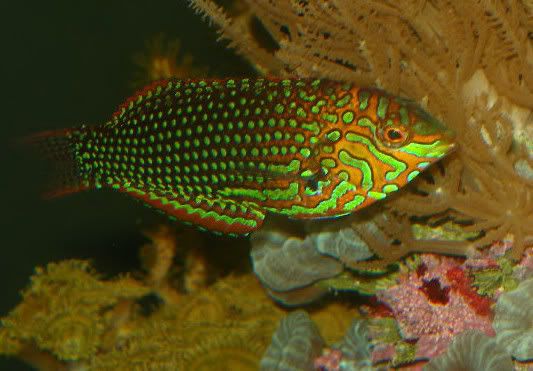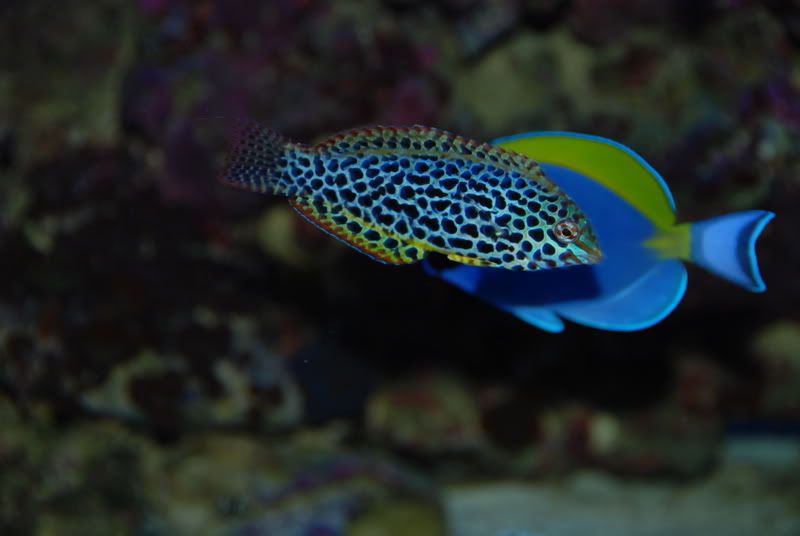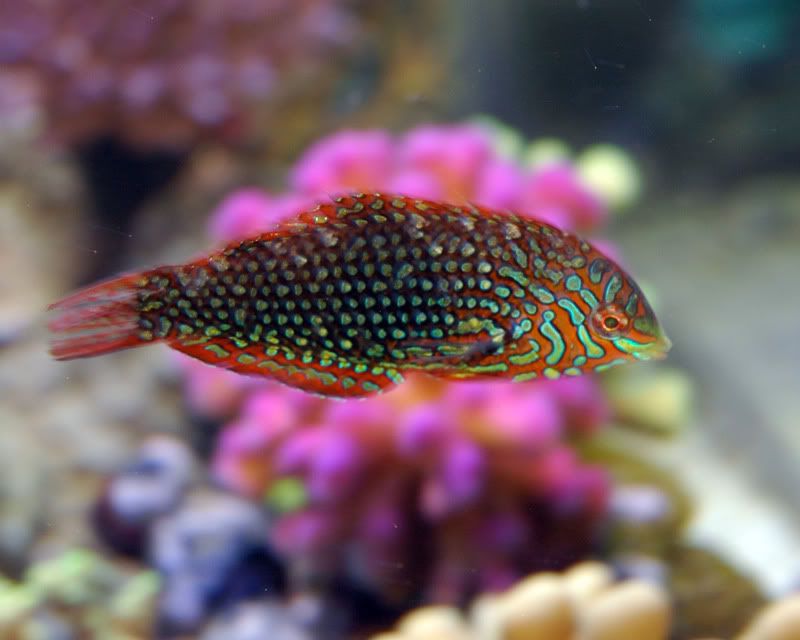
 |
|
#1
|
|||||
|
|||||
|
Does anyone have a leopard wrasse in their tank, and if you do can you tell me a bit of info on them. Thanks Laurie
__________________
One more fish should be ok?, right!!! |
|
#2
|
|||||
|
|||||
|
I have Leopard Wrasses in both my 65g and my 150g....one in each. The first in the 65g eats anything it is fed (frozen, flakes, pellets, etc) lives with shrimp (2 different kinds) and is a model citizen....
Ornate Leopard Wrasse  This is my other Leopard Wrasse in my 150g...again model citizen in the tank....eats acro eating flatworms too.....but also eats any food item I put in the tank, also will pick at Nori for the tangs, was a bit grouchy to the yellow wrasse I put in ...but now they are just fine together 
__________________
No act of kindness, no matter how small, is ever wasted. Sarah |
|
#3
|
|||||
|
|||||
|
Gorgeous,
My Favorite of the Wrasse familly |
|
#4
|
|||||
|
|||||
|
I had one a while back, really pretty fish but always stirring the sand bed looking for food. Kind of annoying
 |
|
#5
|
|||||
|
|||||
|
From what Ive seen they are one of the more sensitive types in the wrasse family. If you get one that eats prepared foods, then you are probably set, but more often than not they end up not eating anything at all... which is a big problem obviously. They key is selection. If you can get an established healthy eating one from a fellow reefer, that would be ideal. If from a store, you need to be more careful; make sure to actually see it eat. Let it sit there a few weeks to make sure there isn't internal damage due to rough shipping, which is a main reason why some large bodied wrasses croak in a short time. Of course, consider that it is a wrasse, so all the specific wrasse rules apply (fine sand bed for it to sleep in, tank cover, etc). Not a beginner fish, but with the right precautions before purchase, a probable survivor.
btw, sarah and steve, gorgeous fish! I have an ongoing love of the leopard wrasses too. |
|
#6
|
|||||
|
|||||
|
We've had a beautiful black leopard wrasse for about 2 months now and he has been a model citizen. He gets along well with my clowns, schooling with them most of the day, and only occasionally does a "swim-by" to my little goby when he's out, just to irritate. He eats a prepared frozen food once a day, and picks during the rest of the day. (He's afraid of anything I clip into the tank, so good thing he eats the frozen food). He would get a little more to eat in the evening, but he tends to be in bed by about 4pm so misses out. (It doesn't seem to be hurting, as he's quite healthy and active.) So far, so good!
|
|
#7
|
|||||
|
|||||
|
Thank-you everyone for the response. I saw one at AI (LFS) and I really like the look of them. The wrasse has been there for over a week but I don't know if he's eating frozen or not, I will ask them to feed the wrasse before I buy it. I have lots of live baby mysis and pods as well as a deep sandbed in my tank so food shouldn't be too much of a problem.
I was kinda worried about my tangs or angels picking on a new fish, however my fish are usually fairly good and so far haven't really picked on any new fish that I've added in the past, so maybe it'll be fine. My tank is an open (no lid/cover) tank and the reason I do not have a wrasse in it is because of how they love to jump. However from what I read on the internet these wrasse's aren't as likely to jump, but I guess it's always a risk. For those of you who own one (great pic.'s btw) do you have a cover/lid on your tank? Again thank-you for your responses.
__________________
One more fish should be ok?, right!!! |
|
#8
|
|||||
|
|||||
|
I have a cover on my tank, but if I compare my goby and blenny with my wrasse, I wouldn't think my wrasse would ever jump, he just seems so calm. Those other two, well..........they can get a little crazy. I can see them doing a little tile surfing!
|